Military tensions Rise in East and Southeast Asia.
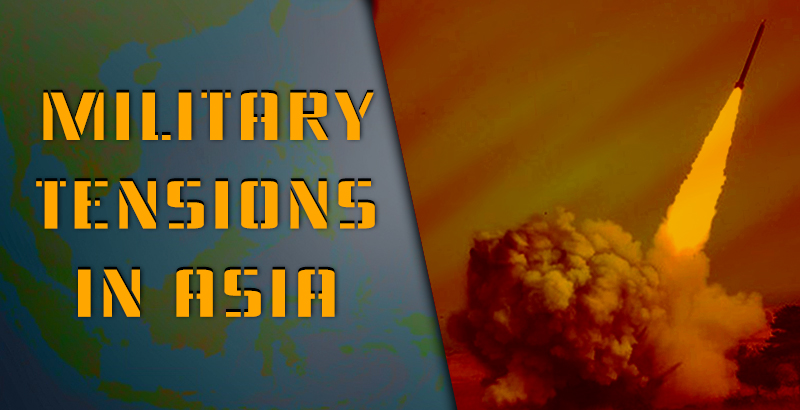
Written by Brian Kalman exclusively for SouthFront; Brian Kalman is a management professional in the marine transportation industry. He was an officer in the US Navy for eleven years. He currently resides and works in the Caribbean.
The month of March is turning out to be a “hot” one in terms of military exercises, drills and posturing. Diplomatic efforts are being overshadowed by high profile, multi-lateral military exercises in the South China Sea, and the Sea of Japan. As China attempts to deescalate tensions in both regions through diplomatic efforts, the North Korea regime continues in its belligerent and dangerous statements and actions, and the joint forces of South Korea, Japan and the United States show solidarity and resolve in staging increasingly complex land and naval exercises. The allied nations made concrete efforts to increase the Ballistic Missile Defense (BMD) capabilities in the region, and China responded by moving ballistic missiles north, close to its border with North Korea.

THAAD arrives in South Korea.
While the USS Carl Vinson CVN-70 and escorting vessels terminated patrols in the South China Sea and have headed north to the Sea of Japan to bolster the South Korean and Japanese position and to engage in military exercises, the USS Green Bay LPD-20 departed southern Thailand and into the South China Sea. The 31st Marine Expeditionary Unit (MEU) had been taking part in the annual Cobra Gold joint exercise with the Thai military, and will be conducting a freedom of navigation patrol in the contested South China Sea with the departure of the USS Carl Vinson. In a far more controversial move, the Japanese Ministry of Defense announced on March 13th, that the nation’s largest vessel, the JS Izumo DDH-183 will be departing her home port of Yokosuka in May for a three month deployment that will take her through the South China Sea and into the Indian Ocean.
Tensions Rise on the Korea Peninsula
As tensions on the Korean peninsula mount, the United States delivered a THAAD missile battery to South Korea on March 6th. The battery was brought onboard a number of C-17 Globemaster heavy transport aircraft which landed at Osan Airbase, approximately 43 miles south of Seoul. The delivery occurred just a day after North Korea launched five ballistic missiles towards the Sea of Japan. Four of the missiles, one failed on launch, struck the open sea approximately 620 miles from their launch site of Tongchan-Ri. It is rumored that the THAAD battery will be based in a rural area roughly 200 miles south of Seoul.
The deployment of THAAD to South Korea has been a contested development from the time it was first seriously proposed last year. China sees the deployment of THAAD as a threat to its ability to respond to a nuclear strike, while both South Korea and the United States have assured China that the system is a defensive countermeasure to North Korea’s increasingly threatening statements and actions over the past year. In August of 2016, as South Korea and the United States began the annual military drill Ulchi Freedom, the North fired a KN-11 ballistic missile from a submerged submarine. The missile flew 300 miles and landed within Japan’s Air Defense Identification Zone (ADIZ). On February 11th of this year, Pyongyang test fired a “medium to long range” ballistic missile, called the Pukguksong-2 into the Sea of Japan. It is believed that the Pukguksong-2 is based on the KN-11. The missile struck the sea after a flight of 300 miles. On March 5th, the North Korean regime test fired a total of five ballistic missiles, one of which failed just after take- off, while the remaining four traveled approximately 620 miles before splashing down in the Sea of Japan.

Map showing the range and approximate area of impact of the four successfully launched ballistic missiles. One missile failed upon lift-off, while four others landed within Japan’s Exclusive Economic Zone (EEZ).
All of these ballistic missile launches have occurred in direct violation of U.N. Security Council Resolution 1695. Adopted in 2006, the resolution bans the sale of all technologies to North Korea that can be used in the development of nuclear weapons and ballistic missiles, and forbids North Korea from conducting nuclear weapons and ballistic missile tests. Coupled with the resent and dramatic assassination of Kim Jong-un’s half-brother with the VX nerve agent in Kuala Lampur International Airport and the alleged execution of five senior officials by anti-aircraft guns, the continued violations paint a picture of an increasingly unstable and dangerous leadership in Pyongyang. While China has been critical of the ballistic missiles tests, they have not been as forceful in their disapproval as South Korea, Japan, the United States, or even Russia in their denunciation of Pyongyang’s activities. In many ways this follows China’s long use of North Korea as a “wild card” in their overriding diplomatic and defense strategy in the region. The misbehaving pariah can always be counted on to draw world focus and attention away from political and military tensions elsewhere.
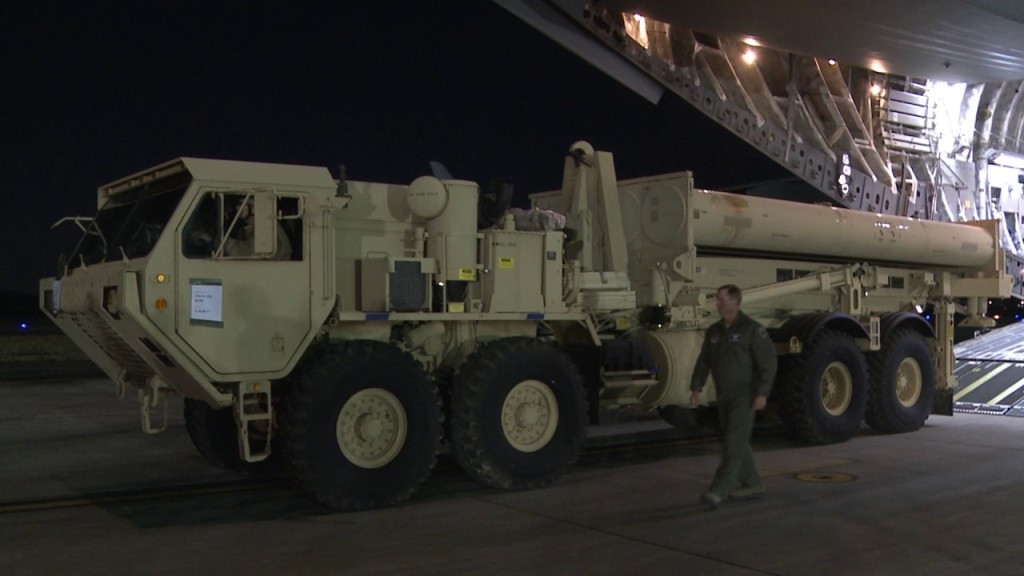
THAAD launch vehicle being discharged from a C-17 Globemaster at Osan Airbase in South Korea on March 6th.
South Korea, Japan and the United States have reacted rapidly and resolutely, to both show solidarity in confronting the ballistic missile threat, as well as institute concrete defense measures to counter the threat in very real terms. The successive ballistic missile tests seem to have ended the delicate subject of whether or not to station THAAD missile batteries in South Korea, with the immediate deployment of at least one battery to Osan Airbase. A THAAD battery consists of six launch vehicles based on the OshKosh Heavy Expanded Mobility Tactical Truck (HEMTT) chassis, each carrying eight missiles in cylindrical launch canisters, a communications and fire control unit, and an AN/TPY-2 X-band radar. The THAAD is designed to intercept medium range ballistic missiles and has a range of 200 kilometers (125 miles). The South Korean government is still in the process of determining the permanent location to base the battery; however, if initial rumors turn out to be true, the batteries will be based in a rural area approximately 200 miles south of Seoul.
In addition to the deployment of a THAAD battery, the U.S. Navy, JMSDF and the ROK Navy carried out a joint missile defense drill between March 14th and March 15th. The Aegis equipped guided missile destroyers USS Curtis Wilbur DDG-54, the JS Kongo DDG-173, and ROKS Sejong the Great DDG-991 conducted a trilateral missile warning information exercise (LINKEX) designed to test the successful communications and interoperability of the Aegis equipped vessels of the different navies. The Carl Vinson Carrier Strike Group was redirected to the area from the South China Sea, where it had been engaged in patrol exercises. The American CSG will be joined by vessels of the ROKN in exercise Foal Eagle-2017. The annual exercises will be conducted from March 1st through April 30th and will test the ability of U.S. ground, air and naval units and their ROK counterparts’ to coordinate and conduct complex, combined arms operations.

ROKS Sejong the Great DDG-991 on station in the Sea of Japan.
China Continues to Fortify its Position in the South China Sea
The void left by the departure of the Carl Vinson CSG in the South China Sea will likely be filled temporarily by the USS Green Bay LPD-20, which had been participating with marines of the 31st Marine Expeditionary Unit (MEU) in the annual, multi-national military exercise Cobra Gold-2017. Cobra Gold has been conducted annually in Thailand since 1982. It is not clear how long the San Antonio Class LPD will remain in the region before returning to its home port of Okinawa, Japan, or if it will officially replace the Carl Vinson CSG in a freedom of navigation mission in the region.
In an announcement that shocked many, and riled the Chinese government, the Japanese Defense Ministry announce that the JS Izumo DDH-183 will depart Japan in May for a three month deployment to test the capabilities of the new vessel. The Izumo was commissioned on March 25th, 2015 and is the first of two vessels in class. Her sister ship, JS Kaga DDH-184 is slated to be commissioned later this March. The Izumo will conduct training exercises with vessels of the U.S. Navy while in the South China Sea. The vessel will visit a number of countries in the region during her deployment, including the Philippines, Indonesia, Singapore and Sri Lanka, before joining vessels from India and the U.S. for the naval exercise Malabar-2017, held annually in the Indian Ocean.
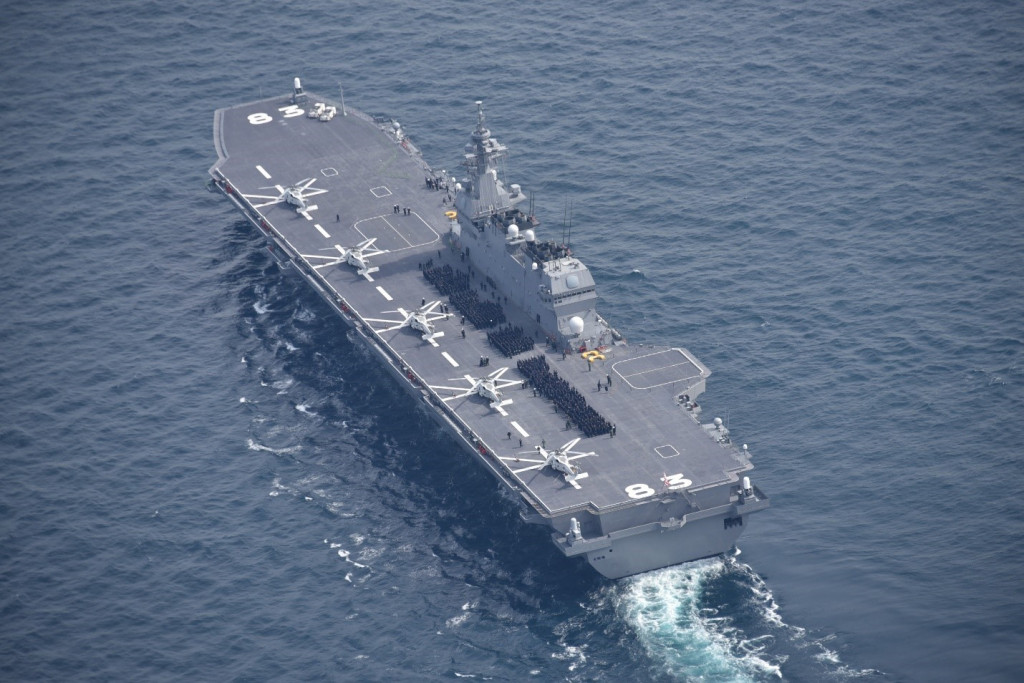
The JS Izumo DDH-183 will soon be joined by her sister ship the JS Kaga DDH-184 which will be commissioned later this month. She is the largest warship to be fielded by Japan since the end of World War II.
Japan’s growing assertiveness in staking a claim to its own national defense will be a stabilizing factor in the Asia-Pacific region in the long run, and will hopefully displace the hegemonic presence of the U.S. military that has taken root in a region that is over five thousand miles away from the continental United States. The United States will be able to downsize and streamline its forward deployed presence in the territories of key allies, while greatly reducing defense budgets that have been ballooning to unsustainable levels, year after year for decades. Japan’s eventual return to a more conventional defense posture should be welcomed by the United States; however, the history of Imperial Japan, which lasted from the Meiji Restoration of 1868 until the enactment of the current Japanese constitution in 1947, has not been forgotten by the many nations that suffered as a result of its imperial ambitions. In response to the Japanese Defense Ministry’s announcement, Chinese Foreign Ministry Spokeswoman Hua Chunying stated that they had requested an official explanation as to why Japan was sending the Izumo through the South China Sea, further clarifying:
“We have not yet heard what Japan says officially. If it’s only a normal visit, going to several countries, and passing normally through the South China Sea, then we’ve got no objections, and we hope this kind of normal exchange between relevant countries can play a role promoting regional peace and stability. But if going to the South China Sea has different intentions, then that’s a different matter.”
“Based on its own interests, Japan has recently been creating problems and polarization over the issue of the South China Sea. This approach has caused strong resentment of the Chinese citizens. Japan continues to do this, and the attempts to have military presence in the South China Sea indicate a threat to the interests of China and increase tensions in the region. China, of course, will take countermeasures in this case.”
China’s Foreign Minister Wang Yi announced on March 8th, that China and the ten nations of the Association of Southeast Asian Nations (ASEAN) had reached a preliminary agreement on a “Code of Conduct” for avoiding and mitigating conflict in the South China Sea. Wang Li reiterated China’s official stance that nations outside of the region should not be involved in either resolving or exacerbating the dispute. Yi went on record saying that,
“We definitely will not allow this stable situation, which has been hard to come by, be damaged or interfered with.”
China continues to strengthen its position in both the Spratly archipelago and the Paracel Islands. Infrastructure improvements to facilities in various stages of construction on multiple natural and man-made islands are still progressing at a rapid pace. Although not receiving as much media attention as developments in the Spratlys, China has strengthened its strategic position in the Paracels so much over the past two years that the islands now all resemble military facilities. China occupied the islands entirely in 1974, after a series of military engagements with Vietnam.
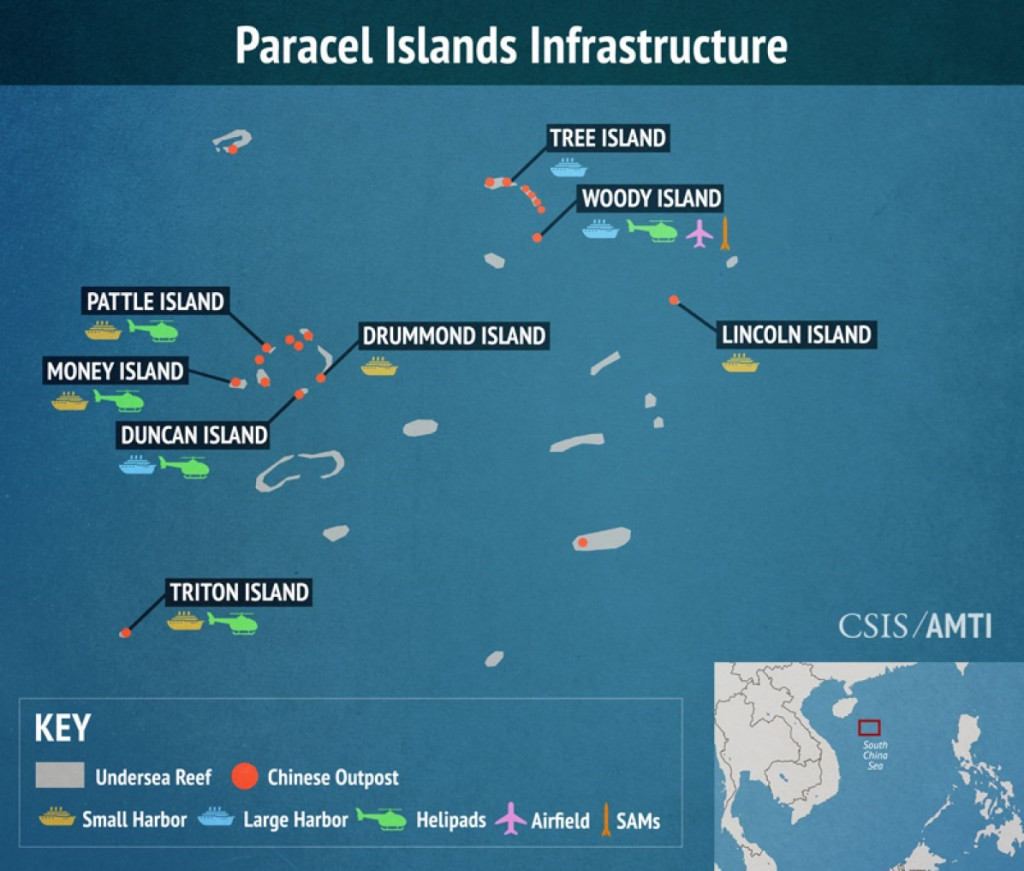
Chinese military bases and infrastructure improvement projects in the Paracel Islands.
Woody Island is the administrative capital of all three of the island groups claimed by China in the South China Sea. It is equipped with a large airstrip of over 2700 meters in length, 16 fortified hangars for fighter or strike aircraft and two large hangers for transport aircraft. In addition, a battery of HQ-9 surface to air missiles is based on the island, as well as YJ-62 anti-ship cruise missiles (which China test fired from the island in the summer of 2016). Nearby Duncan and Palm islands have been turned into one facility, with the water between the two dredged to form a deep water, sheltered harbor. A large helicopter base has been constructed on Duncan Island, complete with eight landing pads and a large hangar and maintenance facility. The island will be able to serve as a major naval replenishment facility and anti-submarine (ASW) base.
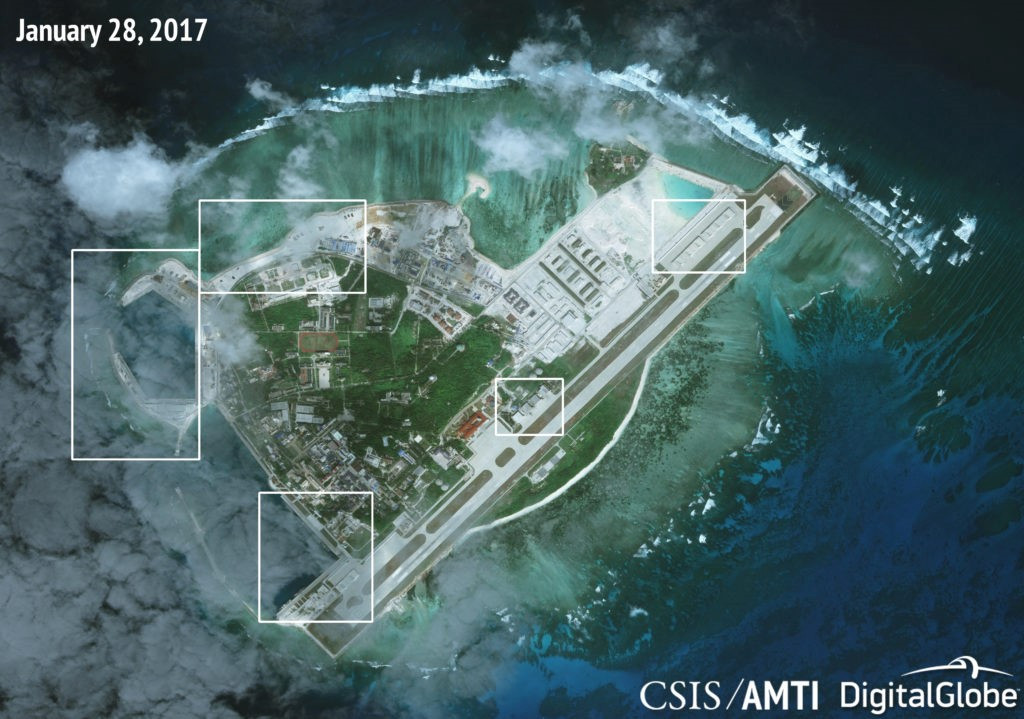
Recent satellite imagery of Woody Island clearly shows the extent of construction on the island. The port facilities in the northwest and southwest corners have been vastly improved, the HQ-9 SAM battery is still deployed on the north beach, and the strengthened aircraft hangars are completed.
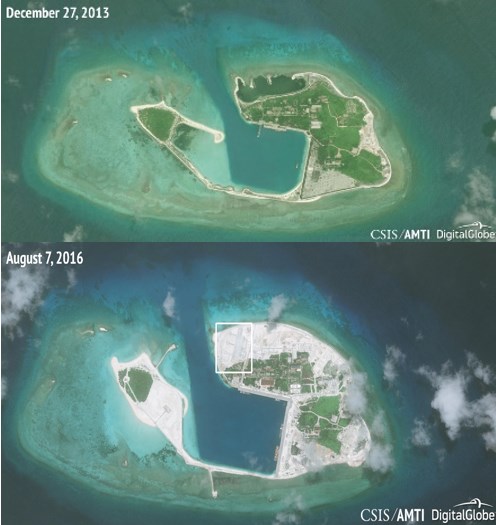
The dramatic changes to Duncan and Palm Islands over a three year period. The dredged, shelter harbor and berthing space for large vessels are well on their way to completion and the helicopter base is clearly visible on the north side of the island.

Helicopter base on the north side of Duncan Island. There are eight landing pads and ample hangar space for storage and maintenance of helicopters of all sizes. It is surmised by some analysts that this base will house ASW helicopters such as the Z-18F or Z-9C Harbin.
Tree Island has also undergone major changes that are clearly visible in satellite imagery. A large harbor has been built on land-fill and various buried structures, possibly strengthened munitions storage, have been constructed on the island. The images below illustrate the dramatic change in the islands over a period of five years.
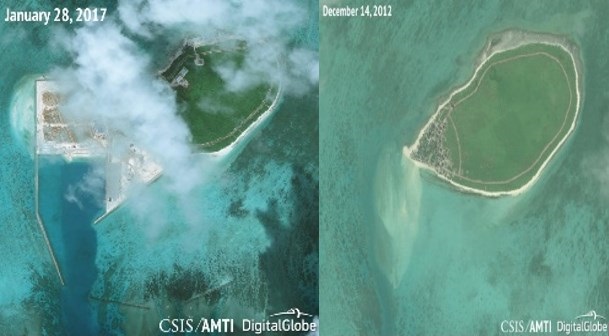
A large area of land reclamation has been added to the west side of the island and developed into a port facility with adjacent above ground buildings and strengthened, underground structures that are most likely munitions storage magazines.
While China’s Foreign Affairs Ministry works to create a legal framework to avoid conflicts and facilitate dispute resolution in the South China Sea, China is also drafting new domestic laws to manage its maritime territory. China has been increasingly backing away from adherence to UNCLOS when it is deemed to be in conflict with Chinese law. In February, the Chinese government announced that it was revising the 1984 Maritime Traffic Safety Law. The draft revisions state that marine safety authorities can designate maritime areas and bar maritime traffic through these areas. The revised law also stipulates that foreign submersibles shall transit Chinese territorial waters on the surface, display their national flag and report to marine traffic control authorities, while foreign warships must also notify marine traffic control and apply for pilotage. China is quite forcefully refuting the centuries old concept of “innocent passage” of warships that was clearly codified into law in UNCLOS in 1982. The United States, although not a signatory of UNCLOS, largely observes the law. China should have mirrored the sound judgement of the United States in 1982 and not signed and ratified UNCLOS, but having done so, it must formulate a multifaceted strategy to prepare the world community for its abandonment of the treaty.
Conclusions
Political and military tensions continue to increase in East and Southeast Asia as the year progresses. It is clear that a combination of political will, diplomatic skill and resolute military preparations on the part of all sides will determine how and when the current crises will be resolved. A new Trump administration has already shown itself to be more timely and decisive than its predecessor in responding to strategic challenges. South Korea and Japan, whom rarely stand in agreement on most international issues, due to long standing animosities and distrust, quickly found common ground in facing a renewed military threat from North Korea. China must now deftly utilize its position of influence over Pyongyang to alleviate the crisis in its favor, while at the same time advancing its position in the South China Sea on all fronts, diplomatic, legal, political and military. The crisis on the Korean peninsula has once again taken the spotlight off of the South China Sea; however, Japan’s controversial move to deploy her largest warship to the region mitigates this opportunity of misdirection for China to a large degree. Japan has clearly decided to support the United States’ challenge of China in the South China Sea. As the Philippines bows out of the fight for all intents and purposes, Vietnam and Indonesia (which is not a party to the dispute) will take on greater importance as spoilers in the larger strategic contest between China and the United States. While Vietnam is in a very difficult position, and is likely to seek diplomatic and military aid increasingly from the United States, Indonesia is in a unique position to leverage its entry into the dispute to its advantage, as a possible ally of either major power.





